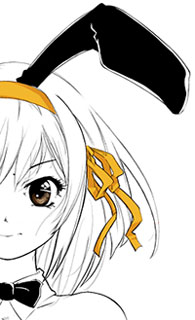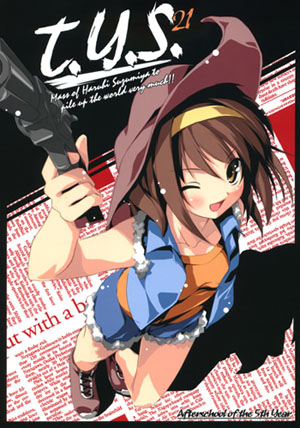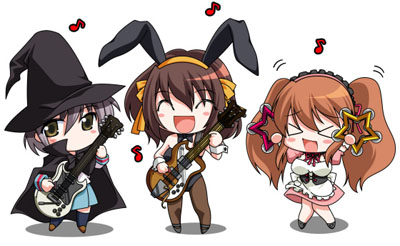
Finally, a new chapter! Sorry it took so long, but I’m lazy. :( This time I’ll introduce Japanese adjectives. Adjective is pretty simple in Japanese so this chapter will hopefully be clear and not as confusing as kanji…
Please make sure you’e read the previous chapters first before continuing as I won’t be explaining the things that I’ve already covered before, such as basic sentence structure and kanji, again.
Suzumiya-sama is the image girl for this chapter.
Lacus will be the image girl for the next chapter.
Introduction

Japanese adjectives are divided into two main groups: the -i adjectives (ã„形容詞) and the -na adjectives (ãªå½¢å®¹è©ž).
In general -i adjectives are native to spoken Japanese that predates kanji (see Chapter III for more on the origins of kanji), while -na adjectives are mostly foreign loan words with Chinese being the majority.
Just like verbs, adjectives in Japanese also have their “dictionary form”, which is the form they appear as in dictionaries and when referred to as a stand alone word.
-i adjectives
-i adjectives can be easily identified by the trailing ã„ (thus their name) that appears in their dictionary form, such as 嬉ã—ã„ (ureshii), 怖ㄠ(kowai) and æ‡ã‹ã—ã„ (natsukashii).
Similar to the trailing hiragana for verbs, the trailing ã„ can be modified to indicate different tenses while the rest of the word is retained. For example, past tense of kowai is kowakatta.
When used to modify a noun, you simply add the -i adjective to the front of the noun. For example, ã‹ã‚ã„ã„猫ã¡ã‚ƒã‚“ (kawaii neko-chan) and 怖ã„æ€ªç£ (kowai kaijuu).
-na adjectives
-na adjectives are usually not easily identifiable in their dictionary form because they look just like nouns. When used to modify nouns, they are usually followed by the particle ãª, thus they are called -na adjectives. I say usually because depending on the tense, na may be replaced by other grammar structures.
Example of -na adjectives include 馬鹿 (baka), ルーズ (ru-zu), å¿«é© (kaiteki) and 憂鬱 (yuuutsu).
By themselves, -na adjectives look exactly like nouns. Take a look at the following sentences.
kana: ã‚ã®äººã¯è¦å¯Ÿã§ã™ã€‚
ro-maji: ano hito wa keisatsu desu
english: That guy is a police officer.
kana: ã‚ã®äººã¯æ†‚鬱ã§ã™ã€‚
ro-maji: ano hito wa yuuutsu desu
english: That guy is melancholic.
憂鬱 (yuuutsu) is a -na adjective while è¦å¯Ÿ (keisatsu) is a noun, but you can’t tell that from the above example without knowing the meaning of both words. And in fact, 憂鬱 can also be used as a noun:
kana: 涼宮ãƒãƒ«ãƒ’ã®æ†‚鬱
ro-maji: suzumiya haruhi no yuuutsu
english: The Melancholy of Haruhi Suzumiya
Thus depending on whether it’s being used as an adjective or a noun, 憂鬱 can mean either “melancholic/gloomy” or “melancholy/gloom”. In a sense, both usages are treated as the same word and it’s up to the context to determine whether the word is being used as an adjective or a noun. This ambiguity is similar to the way the word is used in Chinese which both 憂鬱 and è¦å¯Ÿ originated from. Most -na adjectives can be used as nouns in this manner.

Chuck Norris has got NOTHING on Haruhi
The only time where you can be 100% certain that something is a -na adjective (assuming you don’t know the meaning of the word) is in a sentence such as this:
kana: 彼女ã®æ†‚鬱ãªè¡¨æƒ…ã«èŒãˆã‚‹ã€‚
ro-maji: kanojo no yuuutsu na hyoujou ni moeru
english: I am moé for her melancholic expression.
When the particle na is used, you can be certain that the word before it is a -na adjective, because nouns modify other nouns using the particle no and not na, such as ç§ã®çŒ« (watashi no neko) or æšã®è»Š (akatsuki no kuruma).
So yeah, it’s mostly up to your vocabulary to help you identify -na adjectives because they look just like nouns. But the good thing is that they are so similar that -na adjectives generally follow the same grammar rules as nouns, so it’s not always a problem if you can’t tell whether a word is a -na adjective or not because the rules will apply anyway. Usually.
Negative Form
I think if you’ve watched enough anime, you should know that in negative sentences, the trailing “desu” or “da” (meaning “to be”) that is normally there is instead replaced with “jyaarimasen” or “jyanai“.
kana: 彼女ã¯å®‡å®™äººã§ã™ã€‚
ro-maji: kanojo wa uchuujin desu
english: She is an alien.
Becomes:
kana: 彼女ã¯å®‡å®™äººã˜ã‚ƒã‚ã‚Šã¾ã›ã‚“。
ro-maji: kanojo wa uchuujin jyaarimasen
english: She is NOT an alien.
Note that “desu” and “jyaarimasen” are polite forms of “da” and “jyanai“. It’s part of keigo (which includes polite form, honorific form and humble form). More on that in another chapter. Also note that “jya” is a contraction of “dewa” with the former being used exclusively for spoken Japanese.
Anyway, because -na adjectives are just like nouns, the negative form of -na adjectives is the same as that of nouns.
kana: ç§ã¯æ†‚鬱ã˜ã‚ƒãªã„。
ro-maji: watashi wa yuuutsu jyanai
english: I am not melancholic.
However, -i adjectives follow a different set of rules… “kawaii jyanai” is NOT the negative form of “kawaii“. The correct way to do it is to take off the trailing i and replace it with kunai or kuarimasen (again, just a matter of politeness here).
kana: ã“ã®æ™¯è‰²ã¯æ‚ªããªã„。
ro-maji: kono keshiki wa warukunai
english: This scenery is not bad.
In the example above, 悪ㄠbecomes 悪ããªã„.

Don’t try this at home!
Past Tense
Basically everything that’s been said above still applies.
For -na adjectives it’s quite straightfoward as usual:
憂鬱ã§ã™ã€€â†’ 憂鬱ã§ã—ãŸ
yuuutsu desu → yuuutsu deshita
憂鬱ã  → 憂鬱ã ã£ãŸ
yuuutsu da → yuuutsu datta
It’s just the same as nouns. And the difference between is just politeness level, “desu” and “deshita” being more polite than “da” and “datta“.
For -i adjectives, you have to take off i and replace it with katta.
ã‹ã‚ã„ã„ → ã‹ã‚ã„ã‹ã£ãŸ
kawaii → kawaikatta
ã‹ã‚ã„ã„ã§ã™ã€€â†’ ã‹ã‚ã„ã‹ã£ãŸã§ã™
kawaii desu → kawaikatta desu
Note that a trailing ã§ã™ can be added to -i adjectives to make them polite, but unlike with -na adjective and nouns, ã§ã™ does not indicate the tense of an -i adjective. Both kawaikatta and kawaikatta desu are past tense. There is no such thing as kawaikatta deshita.
Negative Past
For converting negative to negative past (for both -i adjectives and -na adjectives), you can think of the ãªã„ at the end as an -i adjective and change it into past tense in the same way.
憂鬱ã§ã¯ãªã„ → 憂鬱ã§ã¯ãªã‹ã£ãŸ
yuuutsu dewanai → yuuutsu dewanakatta
ã‹ã‚ã„ããªã„ → ã‹ã‚ã„ããªã‹ã£ãŸ
kawaikunai → kawaikunakatta
And you can just add ã§ã—㟠for the polite negative form that ends with ã‚ã‚Šã¾ã›ã‚“.
憂鬱ã§ã¯ã‚ã‚Šã¾ã›ã‚“ → 憂鬱ã§ã¯ã‚ã‚Šã¾ã›ã‚“ã§ã—ãŸ
yuuutsu dewaarimasen → yuuutsu dewaarimasen deshita
ã‹ã‚ã„ãã‚ã‚Šã¾ã›ã‚“ → ã‹ã‚ã„ãã‚ã‚Šã¾ã›ã‚“ã§ã—ãŸ
kawaikuarimasen → kawaikuarimasen deshita

Haruhi is… hot. Literally.
Politeness
I’m too lazy to explain, so here’s a list of examples on how to convert from normal to polite forms. As above, 憂鬱 (yuuutsu) will be used as the -na adjective examples and ã‹ã‚ã„ã„ (kawaii) for the -i adjective examples.
憂鬱ã  → 憂鬱ã§ã™
憂鬱ã§ã¯ãªã„ → 憂鬱ã§ã¯ã‚ã‚Šã¾ã›ã‚“
憂鬱ã˜ã‚ƒãªã„ → 憂鬱ã˜ã‚ƒã‚ã‚Šã¾ã›ã‚“
憂鬱ã ã£ãŸã€€â†’ 憂鬱ã§ã—ãŸ
憂鬱ã§ã¯ãªã£ãŸã€€â†’ 憂鬱ã§ã¯ã‚ã‚Šã¾ã›ã‚“ã§ã—ãŸ ï¼ æ†‚é¬±ã§ã¯ãªã£ãŸã§ã™
憂鬱ã˜ã‚ƒãªã£ãŸã€€â†’ 憂鬱ã˜ã‚ƒã‚ã‚Šã¾ã›ã‚“ã§ã—ãŸ ï¼ æ†‚é¬±ã˜ã‚ƒãªã£ãŸã§ã™
ã‹ã‚ã„ã„ → ã‹ã‚ã„ã„ã§ã™
ã‹ã‚ã„ããªã„ → ã‹ã‚ã„ãã‚ã‚Šã¾ã›ã‚“
ã‹ã‚ã„ã‹ã£ãŸã€€â†’ ã‹ã‚ã„ã‹ã£ãŸã§ã™
ã‹ã‚ã„ããªã‹ã£ãŸã€€â†’ ã‹ã‚ã„ãã‚ã‚Šã¾ã›ã‚“ã§ã—ãŸ ï¼ ã‹ã‚ã„ããªã‹ã£ãŸã§ã™
I’ll explain politeness levels in greater detail in a future chapter.
jyanai vs. –kunai
I mentioned just now that “kawaii jyanai” is not the negative form of “kawaii“. But you still hear people say “kawaii jyanai” sometimes, why?
Well the difference is that “kawaii jyanai” is ALWAYS a rhetorical question, i.e. “Isn’t it cute?”, whereas “kawaikunai” is USUALLY a statement, i.e. “It’s not cute.”
It is not possible to use “kawaii jyanai” as a statement and therein lies the difference.
Just a little note.
Adverbs
Most adjectives can be used as adverbs. For -i adjectives, replace ã„ with ã when modifying verbs instead of nouns. Take 寂ã—ã„ (sabishii) for example.
kana: 彼女ã¯å¯‚ã—ã微笑んã 。
ro-maji: kanojo wa sabishiku hohoenda
english: She smiled lonelily.
And yes, lonelily is really the adverb of lonely. In this case, 寂ã—ã„ (lonely) is changed into 寂ã—ã (lonelily) so as to modify the verb 微笑む (to smile).
For -na adjectives, use the particle ã« instead of 㪠when modifying verbs. Let’s use é™ã‹ (shizuka) as an example.
kana: 彼女ã¯éƒ¨å®¤ã§é™ã‹ã«SFノベルをèªã‚“ã§ã„る。
ro-maji: kanojo wa bushitsu de shizuka ni SF noberu wo yondeiru
english: She’s quietly reading a sci-fi novel in the clubroom.
It’s quite simple really.

Nominalization
You turn adjectives into nouns by using the –sa suffix.
大ãã„ (big) → 大ãã• (bigness; size)
å°ã•ã„ (small) → å°ã•ã• (smallness; size)
é•·ã„ (long) → 長㕠(“longness”; length)
çŸã„ (short) → çŸã• (shortness; length)
高ㄠ(high) → 高㕠(highness; height)
低ㄠ(low) → 低㕠(lowness; height)
And no, “longness” is NOT a word. D:
Some -na adjectives use the –sa suffix too, but generally it is not needed because they can be used as nouns anyway.
The interesting thing is that the nominalization of adjectives with opposite meanings usually give you the same thing. For example, both é•·ã• (nagasa) and çŸã• (mijikasa) are used to mean “length”. You need to look at the context to determine which one to use.
kana: ã“ã®ã‚±ãƒ¼ã‚ã®å¤§ãã•ã¯ã¡ã‚‡ã†ã©ã§ã™ã€‚
ro-maji: kono ke-ki no ookisa wa choudo desu
english: The size of this cake is just right.
kana: ã“ã®ã‚±ãƒ¼ã‚ã®å°ã•ã•ã¯ã¡ã‚‡ã†ã©ã§ã™ã€‚
ro-maji: kono ke-ki no chiisasa wa choudo desu
english: The size of this cake is just right.
The two sentences above translate to the same thing, but they have different implications. The first sentence is saying that the “bigness” of the cake is just right, or the cake is big enough (maybe the speaker is really hungry). The second sentence is saying that the “smallness” of the cake is just right, or the cake is small enough (to eat in one bite, maybe?).
In general though, the “bigger” or “longer” adjective in the pair is used as the generic nominalized form.
That is to say, 大ãã• (ookisa) is used to describe size more often than å°ã•ã• (chiisasa), é•·ã• (nagasa) over çŸã• (mijikasa) and 高㕠(takasa) over 低㕠(hikusa) etc.
The –ki suffix
Long, long ago, using -i adjectives with nouns was not a simple matter of just dumping the adjective in front as it is. People had to convert it to the –ki form first! The horror! Okay, so it’s really just a matter of replacing -i with –ki…

aoki sora…
kana: é’ã清浄ãªã‚‹ä¸–ç•Œã®ãŸã‚ã«ï¼
ro-maji: aoki seijou naru sekai no tame ni
english: For a blue and pure world!
So yeah, the –ki form is really nothing special, just slightly archaic. It also sounds cooler. BTW, a cookie for anyone who knows where the above line is from.
Combining Adjectives
When you use two adjectives to describe an object, you need to first join the adjectives together. If the first adjective is an -i adjective, you need to replace i with kute. If the first adjective is a -na adjective, you need to add de.
kana: 彼女ã¯ç¶ºéº—ã§ã‹ã‚ã„ã„åã§ã™ã€‚
ro-maji: kanojo wa kirei de kawaii ko desu
english: She is a beautiful and cute girl.
kana: 彼女ã¯ã‹ã‚ã„ãã¦ç¶ºéº—ãªåã§ã™ã€‚
ro-maji: kanojo wa kawaikute kirei na ko desu
english: She is a cute and beautiful girl.
Note that the tense is determined by the trailing adjective. Whatever tense that it is in applies to the first adjective too.
Also, you cannot use this grammar pattern for adjectives that contradict each other, even if they are not direct opposites. For example, you cannot say “beautiful and greedy” because one is considered a positive attribute while the other is considered a negative attribute.
Fence Sitters
On an interesting note, there are a few adjectives that can be either -i or -na.
å°ã•ã„ (chiisai) ï¼ã€€å°ã•ãª (chiisa na)
大ãã„ (ookii) ï¼ã€€å¤§ã㪠(ooki na)
å¯ç¬‘ã—ã„ (okashii) ï¼ã€€å¯ç¬‘ã—㪠(okashi na)
The meaning is exactly the same. The -i version is more common, but -na sounds better in a lot of cases because it produces a more distinctive sound and is therefore often used in song lyrics.

You know I just had to include this…
Conclusion
In the fifth chapter, we talked about:
- -i and -na adjectives
- negative, past and negative past
- polite forms of adjectives
- adverbs
- nominalization
- misc. info
The next chapter, when and if it comes, will either be on verbs (again) or politeness levels. Depends on my mood, my horoscope, the alignment of the planets and the next chapter of Suzuka.

She’s no Haruhi but Ryoko is still cool

It’s by the BLUE COSMOS!
Shit. GIVE OTHERS A CHANCE!!!
…here’s your cookie.
*adds a sticky*
another interweb winner.
That “gun to your head move”…yappari Persona 3 sune :P
GOOD LORD MAN, link those picture to the fullsize originals! It’s cruel to tease us with those low-res thumbnails. =)
Boooooo, I was expecting you to throw in more ecchi sentences like you did every other time!
You guys really ask for a lot…
Dont give them anything! Let them suffer!!! Muahahahaha……
Gun to your head? It looks like she’s either playing out Persona3, or else Ryoko’s possessed her, to judge by the crazed look in her eyes.
Wow, I must say I learned more japanese from your few posts than I had in my few years in High School Japanese classes.
All we did was tedious vocab drills.
DarkMirage, your guides started out good and are improving with every chapter–this one by a mile. Thank you!
This is the best thing since Tad Perry’s Quick and Dirty Guide to Japanese!
Very interesting.
A grammar of japanese for japanese student is little different from one for non-native japanese speaker.
I learned i-adjectives as keiyoushi (形容詞:adjectives), but I learned na-adjectives (ãªå½¢å®¹è©ž) as keiyoudoushi (形容動詞) in my junior high school.
And there are some difference between theme.
Off course, I don’t care about it becouse you should learn useful grammar for your purpose.
Yeah, hiroki I heard that too.
Correct me if I’m wrong, but I heard that native Japanese children learn volitional form (æ„å‘å½¢) and negative form (~ãªã„) together under one group, whereas foreigners would tend to associate negative form with the dictionary form and place volitional form in a seperate category.
Well I guess it doesn’t matter as long as it works. XD
I’ve never heard the term “volitinal form” or 「æ„å‘å½¢ã€, so I google it.
I guess that volitional form represent tendency of a person’s mind or “let’s do something”.
今日ã€ã‚¹ãƒ©ãƒ ダンクをèªã¿çµ‚ãˆã‚ˆã†ã€‚
“Today I will finish reading SLAMDUNK.” or “Today I want to finish reading SLAMDUNK.”
一緒ã«ãƒã‚¹ã‚±ãƒƒãƒˆãƒœãƒ¼ãƒ«ã—よã†ã€‚
Let’s play basketball.
I guess that you pointed out the form that someone ask “we do something together?” and the negative form.
一緒ã«ãƒã‚¹ã‚±ãƒƒãƒˆãƒœãƒ¼ãƒ«ã—ãªã„?(Do you play basketball with me)
一緒ã«ãƒã‚¹ã‚±ãƒƒãƒˆãƒœãƒ¼ãƒ«ã—ãªã„。(I do not play basketball with you)
Certainly two sentences above are not distinct in japanese grammar for japanese although they have completely different meaning.
I don’t know why.
It’s in the intonation. I think the conversion from negative-form to question through intonation is universal amongst most languages. I feel that your translation would more accurate this way:
一緒ã«ãƒã‚¹ã‚±ãƒƒãƒˆãƒœãƒ¼ãƒ«ã—ãªã„?(Won’t you play basketball with me?)
一緒ã«ãƒã‚¹ã‚±ãƒƒãƒˆãƒœãƒ¼ãƒ«ã—ãªã„。(I do/will not play basketball with you.)
Maybe my examples are too bad.
In japanese, if you want to make a sentence question form then you should add “〜㋔ to the end of the sentence.
But if you ask me
「一緒ã«ãƒã‚¹ã‚±ãƒƒãƒˆãƒœãƒ¼ãƒ«ã™ã‚‹ã‹?ã€,
I may think “hmm strange japanese. Maybe you are a foreigner”
「一緒ã«ãƒã‚¹ã‚±ãƒƒãƒˆãƒœãƒ¼ãƒ«ã—ã¾ã›ã‚“ã‹ã€(Let’s play basketball.)
is common japanese.
But if you eliminate “ã‹” then the sentence becomes negative form.
「一緒ã«ãƒã‚¹ã‚±ãƒƒãƒˆãƒœãƒ¼ãƒ«ã—ã¾ã›ã‚“ã€(I do not play basketball with you)
Probably, it is not something DarkMirage want to say…
I remember vaguely that someone taught me that the negative-form, when used as a question, is more polite. Perhaps this applies in your example.
But to clarify, with or without the 〜ã‹, the negative form can still be applied as a question, no?
suzumiya haruhi in persona 3. that would be how cool lor. wonder what her persona would be…oO
To kwok:
Off course, a negative form can become also a question form.
But there is one point that you should be careful.
A-san:ãƒã‚¹ã‚±ãƒƒãƒˆãƒœãƒ¼ãƒ«ã—ã¾ã›ã‚“ã‹ã€‚(Let’s play basketball.)
B-chan:ã¯ã„。ã—ã¾ã—ょã†ã€‚
C-kun:ãƒã‚¹ã‚±ãƒƒãƒˆãƒœãƒ¼ãƒ«ã—ãªã„ã®ã§ã™ã‹ã€‚(Don’t you play basketball?)
D-san:ã¯ã„。ã—ã¾ã›ã‚“。
I think that this is not a ploblem whether polite or not.
Possibly my understandings are wrong although I an a japanese,
So I recommend you to ask about it to a teacher of japanese language.
As an unrelated note:
「ãƒãƒ«ãƒ’ã¯äººé–“ã˜ã‚ƒãªã„ã‚“ã˜ã‚ƒãªã„ã‹ã€‚ã€
「ãƒãƒ«ãƒ’ã¯äººé–“ã˜ã‚ƒãªã„ã˜ã‚ƒãªã„ã‹ã€‚ã€
I feel that these are completely different.
But I don’t have enough english ability to explain the difference.
Explaining japanese language is too difficult for me. _| ̄|○
Well, for native Japanese, both ã—ãªã„ and ã—よㆠare used to indicate things that have yet to happen, thus they are taught under one group.
Whereas for foreign learners, it’s more intuitive to group ã™ã‚‹ and ã—ãªã„ together because they seem to be direct opposites. ã—よㆠto us is just a weird grammar structure that doesn’t really have an equivalent in English.
I guess the main problem lies with the fact that ã—ãªã„ can mean either “don’t do” or “will not do” and Japanese doesn’t make that distinction.
The pics sure show your love for the gal. ;)
These Japanese-learning episodes are great..please continue doing these.
By the way, is there such a polite sentece such as takakunai desu(not tall?)
exalt: while you hear it all the time in anime, it’s not proper Japanese. The proper polite form is only “takakuarimasen”.
“大ãã„ (ookii) ï¼ã€€å¤§ã㪠(ooki na)”
like “ookina yume suki desho”? Now where have I heard that before…hmmm..some song lyrics ah…
Hi! Just wanted to thank you for publishing this amazing website. I’m an American college student in a Japanese daigaku, and I have a huge-o test tomorrow on precisely this. You really helped me alot! Thanks, man!
<3
wowww…. alot to memorise.
This chapter is really hard to memorize!
Isn’t there ã‹ missing in some of the following (Politeness part)?
憂鬱ã§ã¯ãªã£ãŸã€€â†’ 憂鬱ã§ã¯ã‚ã‚Šã¾ã›ã‚“ã§ã—ãŸ ï¼ æ†‚é¬±ã§ã¯ãªã£ãŸã§ã™
憂鬱ã˜ã‚ƒãªã£ãŸã€€â†’ 憂鬱ã˜ã‚ƒã‚ã‚Šã¾ã›ã‚“ã§ã—ãŸ ï¼ æ†‚é¬±ã˜ã‚ƒãªã£ãŸã§ã™
For example, shouldn’t 憂鬱ã˜ã‚ƒãªã£ãŸ be 憂鬱ã˜ã‚ƒãªã‹ã£ãŸ?
Please forgive me if I’m wrong and/or just being stupid. ^^
Car shopping is stressful. Now that there are hundreds of makes and models to
choose from, not to mention promotions and payment options, it’s easy to become frustrated and stressed out. The information here will help make buying a car as easy and stress-free as possible.
Here is a helpful video on making Japanese adjectives negative: http://youtu.be/VPVbDZYmV5Y
Hi there to every single one, it’s actually a fastidious for me to pay a quick visit this web page, it contains important Information.
Beginner’s Japanese – Chapter V – Adjectives – Ramblings of DarkMirage
I must tell you that it’s hard to find your articles in google, i found this one
on 21 spot, you should build some quality backlinks in order to
rank your page, i know how to help you, just type in google – k2
seo tips and tricks
My brother suggested I may like this website.
He used to be totally right. This submit actually made my day.
You cann’t consider simply how so much time I had spent for this information! Thank you!
What i do not realize is in reality how you are no longer really a lot more well-preferred than you might be
now. You are very intelligent. You already know therefore considerably when it comes to this topic, made me individually believe it from so many various angles.
Its like women and men don’t seem to be interested until it’s one thing to do
with Lady gaga! Your own stuffs outstanding. At all times take
care of it up!